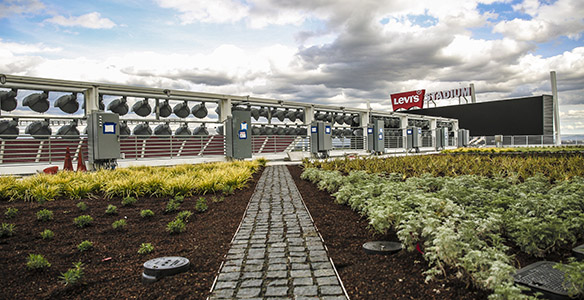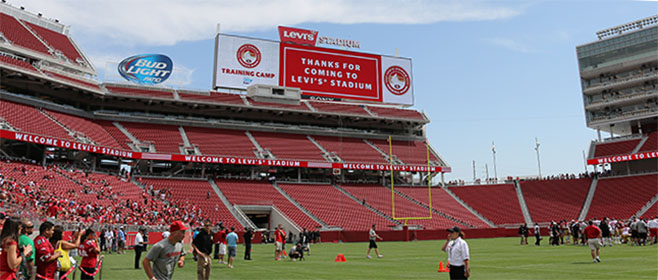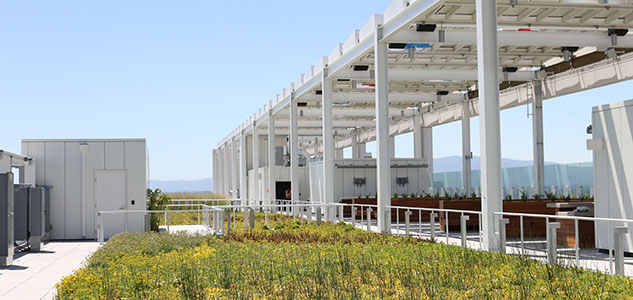The same competitive spirit that 49ers fans are counting on to drive the team to its next championship also inspired the team responsible for the design, construction and operation of the just-opened Leviís Stadium in Santa Clara to find innovative ways to out-green the competition.

The NRG Solar Terrace at Leviís Stadium, which sits atop the stadiumís suite tower, is planted with dozens of species of native vegetation. The terrace will help significantly reduce heating and cooling costs for the tower below.
By Bill Picture
Published: September, 2014
The same competitive spirit that 49ers fans are counting on to drive the team to its next championship also inspired the team responsible for the design, construction and operation of the just-opened Levi’s Stadium in Santa Clara to find innovative ways to out-green the competition.
“Anything less than [Leadership in Energy and Environmental Design Gold Status] wasn’t an option,” said Levi’s Stadium Director of Business Operations Morrie Eisenberg. “When I arrived, the attitude was, ‘Not only are we going to achieve LEED Gold, but we are going to achieve it before we even open.’ What can I say? We’re overachievers. From the very beginning, we set out to overshoot the bar.”
And overshoot it they did, scoring 41 points when only 39 were needed to nab the facility a gold rating.
Location, location, location
Levi’s Stadium boasts an impressive array of green elements that have already raised the bar for sustainable stadium design. Easy accessibility for pedestrians, bicyclists and transit-riders may not be the sexiest of the stadium’s green features, but it’s definitely an important one—as any 49ers fan who has sat in traffic getting to and from Candlestick Park will attest.
“The best thing we could do is provide fans with options,” Eisenberg said. And to that end, the 1.85 million square-foot stadium is easily accessible via Santa Clara Valley Transportation Authority (VTA) light rail and bus lines, Altamont Corridor Express (ACE) and Capitol Corridor trains, and CalTrain (via a VTA light rail connection in Mountain View). Fans living or working nearby also have the option of walking to the stadium using the San Tomas Aquino Creek Trail, a feeder trail to the San Francisco Bay Trail.
The stadium’s seating capacity of 68,500 fans could mean a lot of vehicles on the road. But by offering fans alternatives to driving to a game, 49ers management hopes to significantly reduce emissions, as well as lessen game-related traffic congestion in the area and the road rage that goes with it.
Many of the stadium’s other green attributes, while not immediately apparent, are remarkable. Forty percent of the materials used in the construction of the stadium were recycled or reused, and 75 percent of the construction waste was diverted from landfills. Reclaimed water will also be used to irrigate the playing field. While these things won’t be apparent to most people walking into the stadium, Eisenberg believes that Bay Area football fans demand every effort possible be made to ensure their game-going experience—like the rest of their lives—reflects their eco-minded values.
“I can’t speak to what’s important to football fans in other parts of the country, but this is the Bay Area,” he said. “Living and working green is a part of our culture here, and everyone feels a responsibility to do their part. Sustainability is important to our fans, and it’s important to us.”
The icing on the green cake
What will be obvious to the fans filing into the stadium are the special features that architecture firm HNTB dreamed up just for this project—the extras, you might say.
“A lot of the time, you’re trying to find ways to be more sustainable without impairing the fan experience,” Eisenberg said. “But these particular features actually enhance that experience.”
For starters, the roofs of the three pedestrian bridges that game-goers will use to access the stadium from the main parking area are topped with solar panels from NRG Solar. In addition to providing shade, these panels—along with additional panels atop the suite tower—are expected help the stadium generate enough clean electricity in a year to power all 10 of the 49ers’ scheduled home games.
“And fans can track that energy and water use on a live dashboard installed between the 49ers museum and the team store,” Eisenberg said. “They can see the building at work, and we think they’ll appreciate learning about what we’re doing to help the environment while providing them with a really awesome game day experience.”
The pièce de résistance, however, is the 27,000-square-foot green roof. Planted with 16 different varieties of native vegetation, the roof garden, in addition to being the stadium’s most recognizable feature, will drastically lower heating and cooling needs for the suite tower below, not to mention lend a dash of zen to a rowdy game day. “We really tried to think of everything, and do anything and everything we could in terms of sustainability,” Eisenberg said. “We had a clean sheet of paper to start with, so why not go crazy?”
“And we applied that thinking all the way down to how we purchase our consumables,” Eisenberg continued. “Every effort is being made to buy local and organic. That even goes for the wines that we’re serving. I mean it, we really tried to do it all.”
Eisenberg stops short of predicting that green stadiums like the 49ers’ will eventually be the norm, but he does believe that the desire to live, work and play green is growing. “I think this stadium design mimics what our fans want,” he said. “And I think that more and more people in general are recognizing that these efforts aren’t just nice gestures; they’re necessary. So I’m inclined to think that everything will move in this direction.”
Images provided by Santa Clara Stadium Authority

Leviís Stadium, new home of the San Francisco 49ers, boasts a Leadership in Energy and Environmental Design (LEED) Gold rating, making it a bar-setter for stadium-design moving forward. Sustainable measures were incorporated into every aspect of the buildingís design, construction and operation.

The solar panels on the NRG Solar Terrace will help Leviís Stadium produce enough clean energy to power all of the 2014-2015 season home games. The pedestrian bridges that fans will use to access the stadium from parking areas are also outfitted with solar panels.

